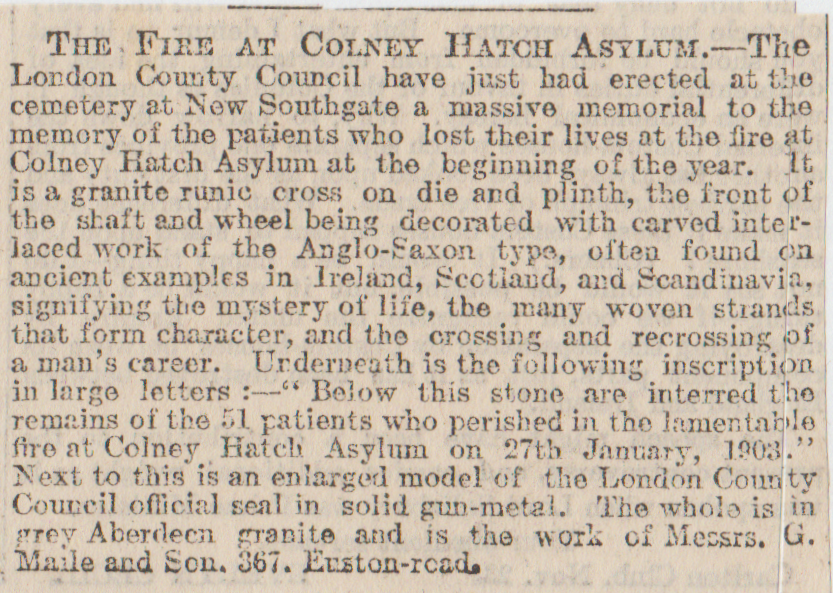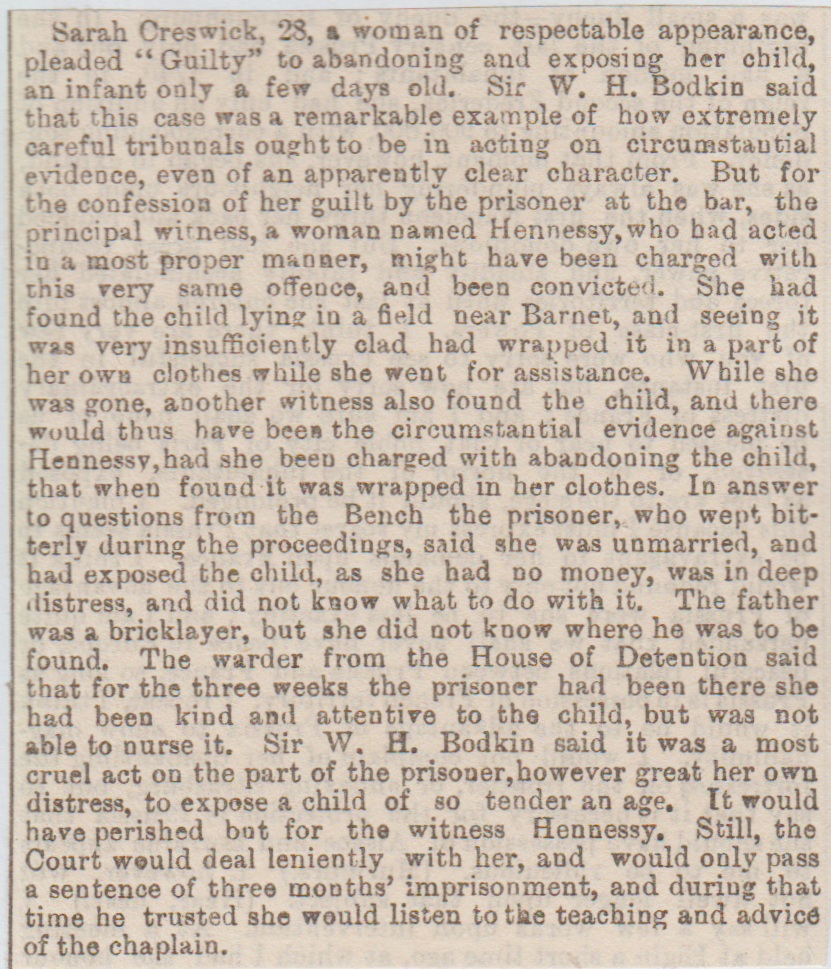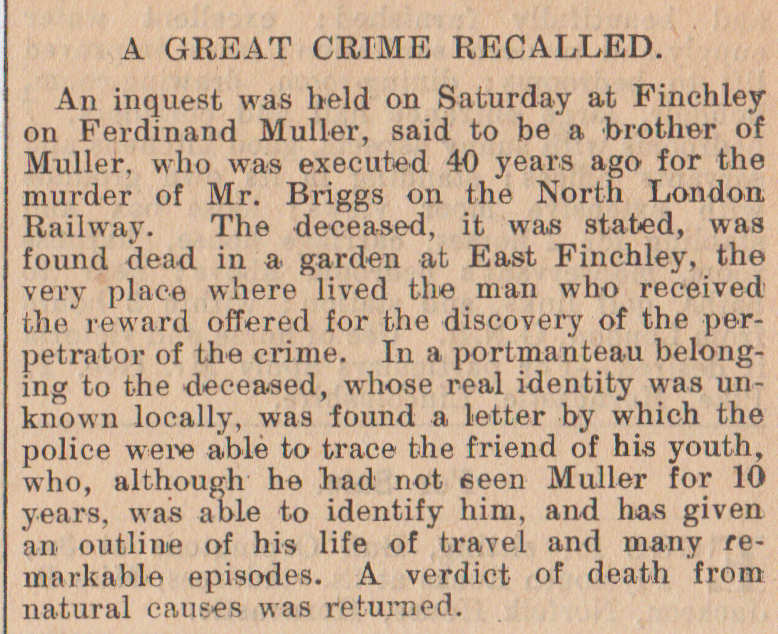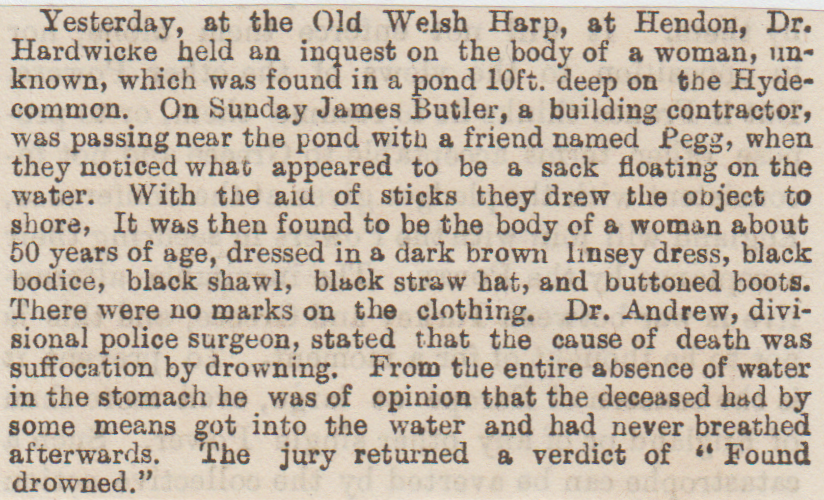1/ Colney Hatch Lunatic Asylum Fire, Barnet, January 27th, 1903
A massive fire swept through the Lunatic Asylum at Colney Hatch (now Friern Hospital) on this day in 1903. Altogether fifty-two women perished in the fire and the funeral was attended by thousand’s who lined the streets. Thirteen hearses took the fifty-one coffins to New Southgate Cemetery. Colney was the largest of the London asylum’s, with a total of 2500+ inmate’s (900 males & 1600 females). It cost £400,000 to build and was erected in 1851. The staff of fifty medical officer’s, one hundred and ninety male servant’s & two hundred female servant’s, plus fifty groundsmen and workers. (Fire was in Ward X5)
November 24th, 1903. Colney Hatch Fire Memorial.
2/ Colney Hatch, July 1878
Elizabeth Berwick, a 46-year-old inmate whose husband worked as an official at West India Docks, Limehouse and who had been here for more than four years. She had been brought to the establishment because of her suicidal tendencies. She was found hanging by her bedsheets from the bars of the windows, she was cut down but was barely alive, and died within the hour. She had tried the same thing at Hanwell Lunatic Asylum a number of times. Not a surprising verdict in an asylum-Committed suicide while of unsound mind.
3/ Colney Hatch Asylum Murder, April 1882
Henry Sands, alias Williams was killed in Colney Hatch Lunatic Asylum by fellow inmate Samuel Fereday. At four o’clock the deceased was working in the farm area when an attendant named Hill heard a cry and he saw Fereday legging it away from the body. His shovel was next to the body. A witness asked him what had he done and he said “nothing”. Strangely though Fereday was a sedate patient, no trouble at all but had complained of headaches that day. It took only five minutes from the act being committed to the death of Sands. Fereday said the patients had been “guying” him and Sands as well, they would chew tobacco and spit the juice in his beer. They said “they would have my head,” he told them afterwards and this was his revenge for being goaded and made fun of. He struck him four times with a shovel with serious force. The verdict was one of “Wilful Murder”.
4/ Children Die in Fire, Hendon, February 1899

5/ Finchley Child Murder, March 1877
An inquest was held on the discovery of a child’s body in a pond at Church End. Thomas Sorrell, a builders son, found the infant when he was with a group of lads, and he’d poked it with a stick and turned it over, then saw the baby’s foot. He ran to get a policeman and P.C.Izzard was nearby, and he came to examine the corpse. Dr Wright said it was badly decomposed and his approximation of time of death would be two months ago. The skull bones were separated and there was no brain or other organs, these had apparently been removed. Its arms had been tied together with twine. The lungs had putrified so there was no real evidence whether the child been murdered or ever breathed at all. What a way to go though, poor little bugger!
6/ Welsh Harp Suicide, Hendon, May 1884
Winifred Jessie Spray, a milliner by trade, killed herself on the Midland Railway. She had been a patient of a lunatic asylum twice before but had been let out and been given the all-clear. Spray left Childs Hill, where she was residing at the time, and went to Kilburn in search of a job. The morning after her job-search, she was found in a mutilated condition on the railway tracks not far from Welsh Harp. A scrap of paper was found, and she’d written the following words:-
“I am mad-everybody knows it. I am going to the bottomless pit. It is an awful thing. It is a rash act. I am going now”.
7/ Welsh Harp Reservoir, Hendon, February 1909 (Skating Accident)
A tragic skating disaster ended with five people losing their lives at the Welsh Harp Reservoir in Hendon. Three men and two boys were in the centre of the lake, about 100 yards from the bank when the ice cracked and they all fell into the freezing water. Few people were in the vicinity but some brave souls made the effort to save them. One bloke with a lifebelt on tried to get through the ice to help them but all to no avail. All that could be seen was two hats floating on the Reservoir surface. Three men jumped in a boat and tried to get them with grappling hooks and they brought up the body of a soldier and a young lad. Five doctors had rushed to the scene but all efforts to restore animation to the bodies were useless.
8/ Childs Hill Suicide, February 1891
A Midland Railway inspector named William Warriner was strolling the railway line between West End Station and Childs Hill when he came across the mangled body of a young girl. The head was caved in and the brains were on the other side of the rails. Childs Hill Station officials found the foot of the girl, which had been discovered twenty yards from the body. At the post-mortem examination, they found an address on the undergarments, and this to her being identified as Kate Carter aged 15, a domestic servant. She lost her job a while back and was staying at a mate’s house at 25, Netherwood Street, West Hampstead. She went to get a character reference from an old employer of hers but wasn’t seen again until she was found on the tracks. Her footprints were next to the fence which means she’d climbed over it, to get to the railway. It seems it was suicide, and the Scotsman passed this area at 7:50, and was travelling at 40 m.p.h., so this was never going to fail.
9/ New Barnet Suicide, July 1889

10/ High Street Suicide, Barnet, July 1888
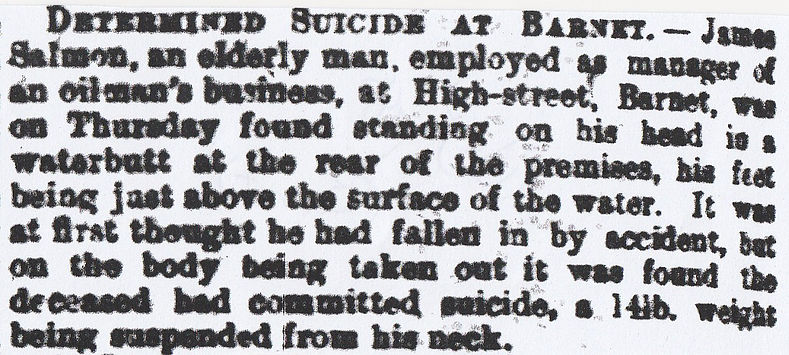
11/ Colney Hatch Suicide, August 1903
A suicide in an asylum is likely to have some strange variations on how it is committed. Henry Seaton, aged 35, was habitually trying to kill himself. He tried to tear out his own tongue several times but two or three months ago, he told staff that he’d swallowed a large piece of wood. They dismissed this as the rantings of a madman. The post-mortem of his body, revealed a chunk of wood nine inches long in his stomach with one end puncturing the lining, this caused inflammation then an abscess, which in the end caused his death. Doctors said that if they had listened to him in the first place they could have operated and saved his life. The fact that he’d swallowed such a huge piece of timber and lived for a few months is in itself a minor miracle. The wood went into the stomach instead of lodging in his windpipe. Seaton’s sister mentioned at the inquest that he tried to commit suicide by swallowing a snuffbox, but that failed.
12/ Colney Hatch Asylum (Mistreatment of a Patient) May 1860
Yep. Colney Hatch again! This is the mistreatment of a patient by an attendant which caused his death. William Swift was found injured, suspected to have been caused by two attendants, Vivian and Slater. He had eleven ribs and his breastbone broken, and Sam Clark told the hearing “On the 12th of May, I saw Swift brought in from the exercise yard, by Mr Slater and Mr Vivian. They took hold of him by the arms. Vivian had hold of his collar. He said, “Don’t take hold of me, and I will go anywhere with you”. Vivian then let go of his collar and took hold of his arm. They took him into the ward and tripped him up. They threw him on the floor and ill-used him. Vivian kicked him and Slater punched him. They then got him up and took him to the door of the padded cell, where they undressed him and pushed him in. He was calling so that they must have heard him all over the exercise yard. He said, “Kill me at once; don’t kick me like that”. Slater had been out with some of the patients and when he came in, Vivian said to him “I’ve been waiting for you, I can’t keep Swift out of the ward”. Slater said “Take him at once”, and they took him in. Slater got us to bed earlier than usual that night.”-(What was the outcome?)
13/ Colney Hatch Asylum Murder, November 1861
A case of murder was the unlikely scenario at Colney Hatch this time. Joseph Bigg aged 28, was an inmate of the Asylum and he resided at No 14 Ward, where the dirty and noisy patients were, and they had attendants watching their every move. He was found by Sam Rickman an elderly inmate on Tuesday afternoon with a blue handkerchief tied around his neck. He was face down on the floor next to a press and Rickman kept mumbling “My poor boy is dead”. Rickman was like a father to him, watching him and feeding him, and he told staff and police that he saw a patient named Skinner strangle Bigg. Skinner said he’d been elsewhere in the asylum and denied having anything to do with his death. Unfortunately, in an asylum, nobody’s word can be taken for granted or used in evidence because they are all stark raving mad in the eyes of the law. This was the case here. It was just Skinner’s word against Rickman’s, and the verdict was that the deceased had been “strangled by a person or persons unknown”.
14/ Silk Bridge near Hendon, January 1880

15/ New Barnet Child Murder, April 1895
The body of a little girl, Lydia Hill, only six and a half years of age, was discovered in a field in New Barnet. She died from loss of blood and shock to the system, as a result of terrible injuries inflicted in the act of rape, in what seems to be a frenzied attack. Police have already arrested a man on suspicion of her murder. Ada Baker and Hettie Julian, friends of Lydia, identified the man, whose name is Osborne. Detective Inspector White of Scotland Yard is going to charge him with causing the death of a child and with rape.
16/ Barnet Suicide, January 1890
Sunday nine a.m., and the stationmaster at New Barnet, Mr Redford, told East Barnet police that a man’s body had been found on the embankment near to Hadley Woods bridge. An officer went to the scene of the suicide, and the first thing that was obvious was that he’d been dead for a number of hours. He was smartly dressed, his head was near to the train tracks with a gun in his right hand. Above his right ear was the entry wound, and the positioning of the body suggests that he meant to shoot himself, then for the body to lay across the rails, and to make certain, have a train run over him. He was wearing a gold ring, gold cuff-links, a bit of cash, crocodile skin pipe, etc, all give the impression that he was of good breeding. A calling card with the name “Austin H.Turner” was also in his pocket, and he was about forty years of age, 5 feet 8 inches, with brown hair, and a dark moustache. (Who was he ?)

